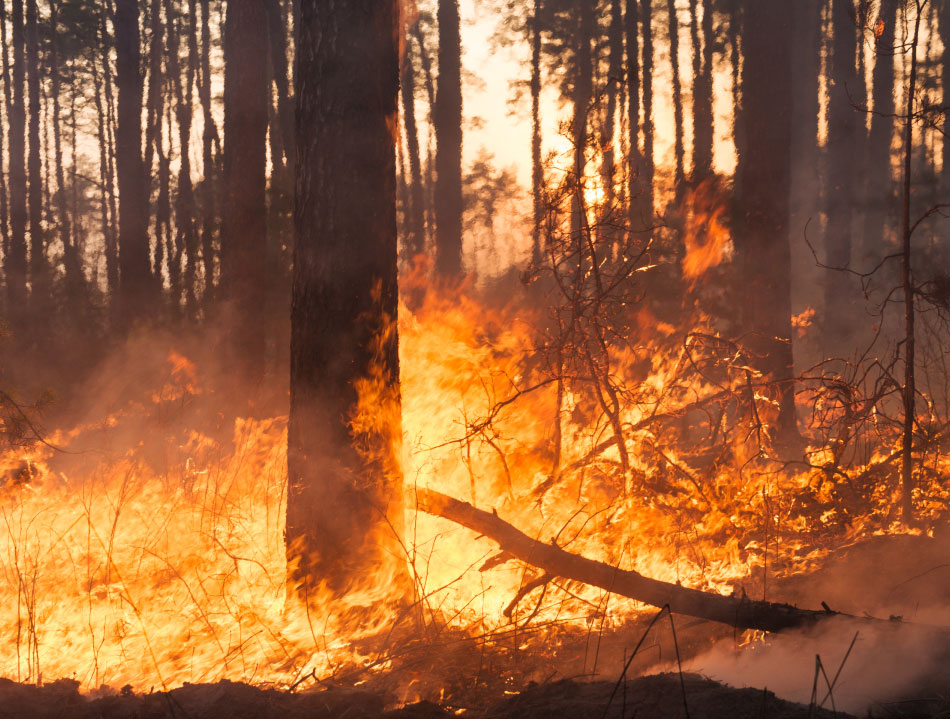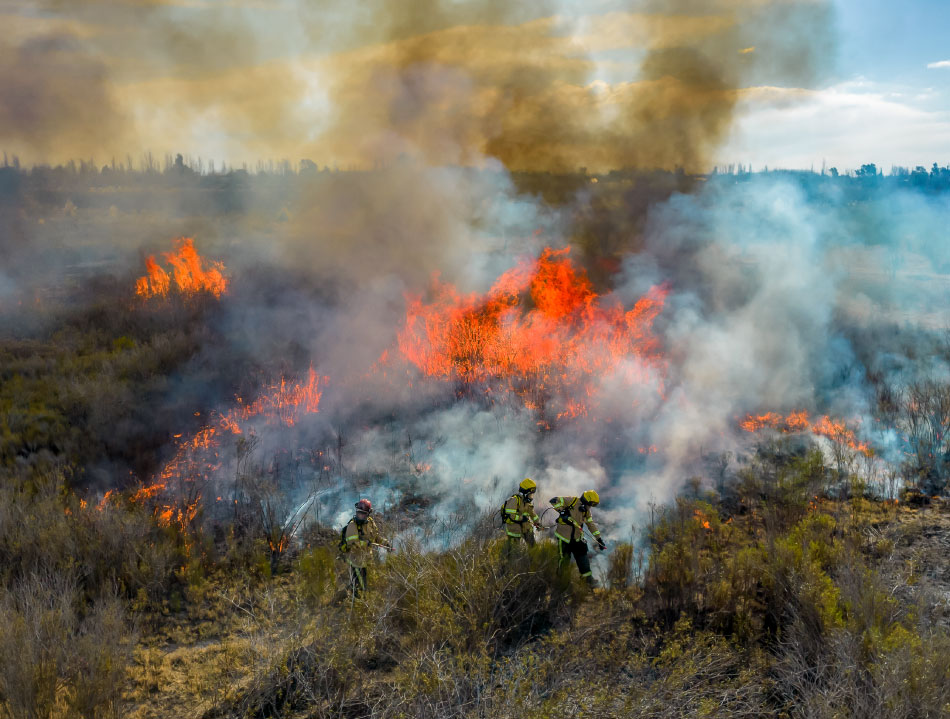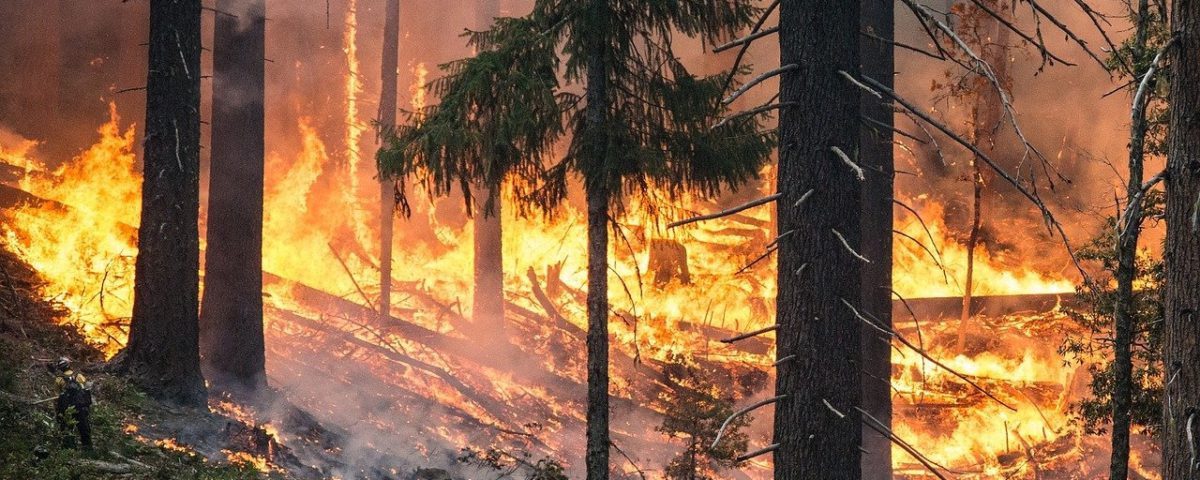
California regularly experiences major wildfires that are devastating to the environment and communities throughout the state. California wildfire history is one of destroyed property, displaced residents, dangerously poor air quality, extreme heat, and other consequences.
California wildfire statistics and history hold insights and lessons that are invaluable for protecting your home and loved ones. We share this information in the hope that learning from the past will prevent future losses.
California wildfire statistics by year.
The government collects and shares California wildfire data which measures the impact that wildfires have on residents, structures, and the environment. The following wildfire statistics cover the years from 1987-2023:
| Year | Number of Wildfires | Acres Burned |
| 1987 | 13,476 | 873,000 |
| 1988 | 13,290 | 345,000 |
| 1989 | 10,024 | 173,400 |
| 1990 | 10,548 | 365,200 |
| 1991 | 9,609 | 44,200 |
| 1992 | 12,047 | 282,745 |
| 1993 | 8,689 | 309,779 |
| 1994 | 10,269 | 526,219 |
| 1995 | 8,492 | 209,815 |
| 1996 | 10,610 | 752,372 |
| 1997 | 9,502 | 283,885 |
| 1998 | 7,572 | 215,412 |
| 1999 | 11,125 | 1,172,850 |
| 2000 | 7,622 | 295,026 |
| 2001 | 9,458 | 329,126 |
| 2002 | 8,328 | 969,890 |
| 2003 | 9,116 | 1,020,460 |
| 2004 | 8,415 | 264,988 |
| 2005 | 7,162 | 222,538 |
| 2006 | 8,202 | 736,022 |
| 2007 | 9,093 | 1,520,362 |
| 2008 | 6,255 | 1,593,690 |
| 2009 | 9,159 | 422,147 |
| 2010 | 6,554 | 109,529 |
| 2011 | 7,989 | 168,545 |
| 2012 | 7,950 | 869,599 |
| 2013 | 9,907 | 601,635 |
| 2014 | 7,865 | 625,540 |
| 2015 | 8,745 | 893,362 |
| 2016 | 6,986 | 669,534 |
| 2017 | 9,560 | 1,548,429 |
| 2018 | 8,527 | 1,975,086 |
| 2019 | 7,860 | 259,823 |
| 2020 | 9,639 | 4,397,809 |
| 2021 | 8,835 | 2,568,948 |
| 2022 | 7,490 | 362,455 |
| 2023 | 7,127 | 324,917 |
The numbers paint a grim picture of destruction of uninhabited land as well as structures, homes, and even whole towns.It’s impossible to guess how many California wildfires in 2024 will start, or how many acres will burn. What’s certain is that thousands of fires will roar across the state. That’s why it is so important to stay aware of current wildfire incidents through our California Wildfire Map, and why it’s extremely helpful to have our wildfire tracker app (Android | iOS) on your phone.
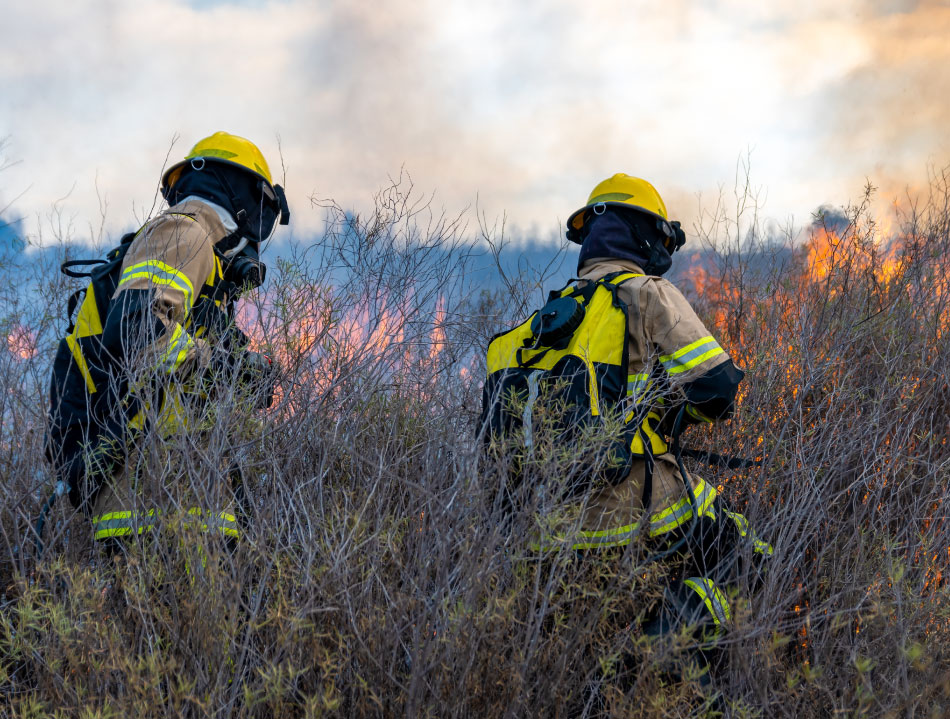
California wildfire trends by decade.
California has always been vulnerable to wildfires. The Environmental Market Solutions Lab at the University of California Santa Barbara (UCSB) and The Nature Conservancy published the average number of fires and acreage burned over 10-year intervals, which we’ve summarized for you, below.
California wildfire statistics vary year by year, driven in part by the climate. A long drought ended in 2024, however the California fire season may be worse by summer’s end, as the increase in vegetation thriving in wet spring conditions dries in late summer, providing a large fuel source for wildfires.
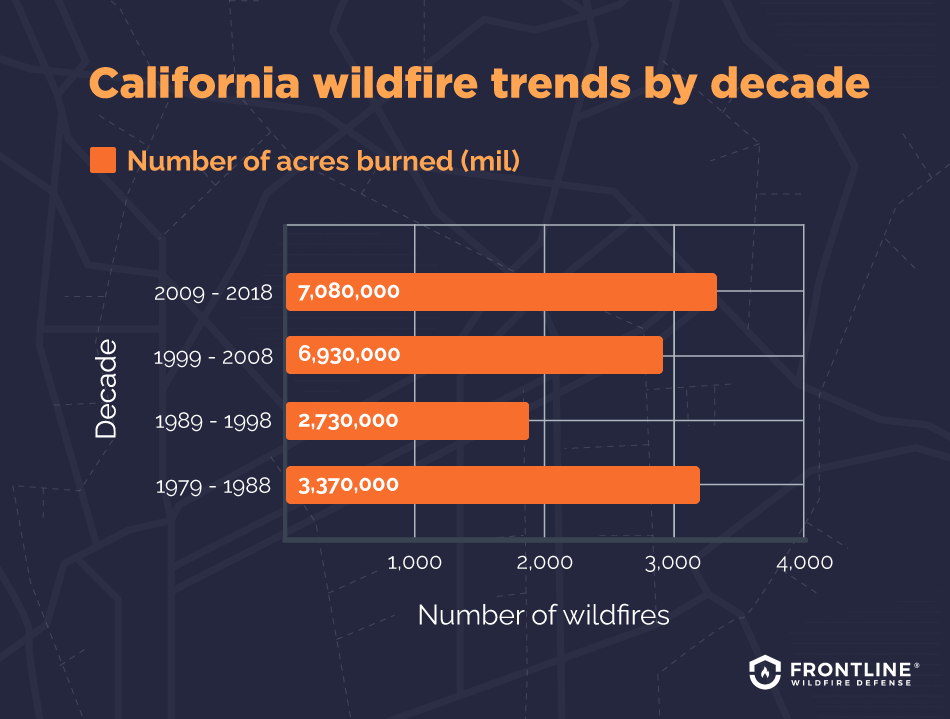
| Decade | Number of Wildfires | Acres Burned (mil) |
| 1979-1988 | 2,413 | 3.37 |
| 1989-1998 | 1,910 | 2.73 |
| 1999-2008 | 2,947 | 6.93 |
| 2009-2018 | 3,356 | 7.08 |
What were the most destructive wildfires in California’s history?
California’s wildfire history of thousands of fires causing billions of dollars in destruction every year is mostly due to many small-scale, individual fires. Yet, larger fires are becoming more common. This list of California wildfires highlights the largest wildfires in California history, which resulted in extreme levels of destruction. While lightning strikes sparked some of them, the overwhelming majority were caused by human activity.
| Ranking | Wildfire Name | Structures Destroyed | Acres Burned | Year | Fire Cause | Deaths | County |
| 1 | Camp | 18,804 | 153,336 | 2018 | Powerlines | 85 | Butte |
| 2 | Tubbs | 5,636 | 36,807 | 2017 | Electrical system | 22 | Napa & Sonoma |
| 3 | Tunnel | 2,900 | 1,600 | 1991 | Extinguished fire rekindled | 25 | Alameda |
| 4 | Cedar | 2,820 | 273,246 | 2003 | Human related | 15 | San Diego |
| 5 | North Complex | 2,352 | 318,935 | 2020 | Lightning | 15 | Butte, Plumas, & Yuba |
| 6 | Valley | 1,955 | 76,067 | 2015 | Electrical system | 4 | Lake, Napa, & Sonoma |
| 7 | Witch | 1,650 | 197,990 | 2007 | Powerlines | 2 | San Diego |
| 8 | Woolsey | 1,643 | 96,949 | 2018 | Electrical system | 3 | Ventura |
| 9 | Carr | 1,614 | 229,651 | 2018 | Human related | 8 | Shasta County & Trinity |
| 10 | Glass | 1,520 | 67,484 | 2020 | Undetermined | 0 | Napa & Sonoma |
| 11 | LNU Lightning Complex | 1,490 | 363,220 | 2020 | Lightning & arson | 5 | Napa, Solano, Sonoma, Yolo,Lake, & Colusa |
| 12 | CZU Lightning Complex | 1,355 | 86,509 | 2020 | Lightning | 1 | Santa Cruz & San Mateo |
| 13 | Nuns | 1,355 | 54,382 | 2017 | Powerlines | 3 | Sonoma |
| 14 | Dixie | 1,311 | 963,309 | 2021 | Powerlines | 1 | Butte, Plumas, Lassen, Shasta, & Tehama |
| 15 | Thomas | 1,063 | 281,893 | 2017 | Powerlines | 2 | Ventura & Santa Barbara |
| 16 | Caldor* | 1,003 | 221,774 | 2021 | Under investigation | 1 | Alpine, Amador, & El Dorado |
| 17 | Old | 1,003 | 91,281 | 2003 | Human related | 6 | San Bernardino |
| 18 | Jones | 954 | 26,200 | 1999 | Undetermined | 1 | Shasta |
| 19 | August Complex | 935 | 1,032,648 | 2020 | Lightning | 1 | Mendocino, Humboldt, Trinity, Tehama,Glenn, Lake, & Colusa |
| 20 | Butte | 921 | 70,868 | 2015 | Powerlines | 2 | Amador & Calaveras |
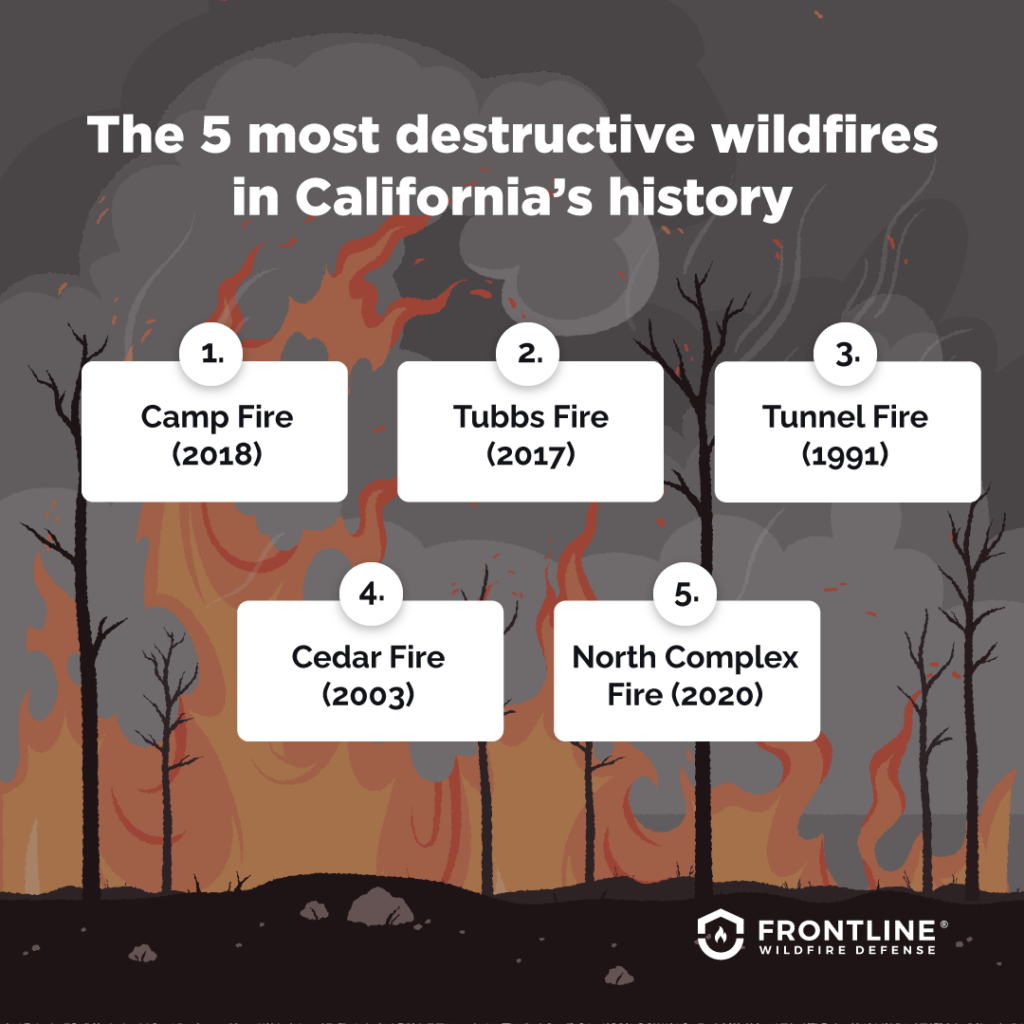
Let’s take a closer look at the five most destructive and deadliest wildfires in California history to understand their causes and the conditions that led to them growing out of control so quickly.
Camp Fire, the most destructive and deadliest California wildfire (2018).
A malfunctioning Pacific Gas & Electric Co (PG&E) transmission line was all it took to spark the deadliest wildfire in California history, back in November 2018. What became known as the Camp Fire consumed over 153,000 acres of land in Northern California, destroying nearly 19,000 structures and killing 85 people. The fire destroyed the towns of Paradise and Concow, which lost 95% of their structures, and displaced 27,000 people in Paradise alone.
The fire drove changes in forest management, electric grid maintenance, evacuation planning, and building codes in an attempt to prevent future wildfires from being as destructive.
About the Tubbs Fire (2017).
A malfunctioning electrical system started the second-largest wildfire in California history, in the wine country of Northern California. A privately built and operated electrical system started the Tubbs Fire in October 2017 that grew across 36,800 acres, destroying 5,636 structures and damaging another 317. The town of Santa Rosa suffered the most, losing 5% of its housing stock and 22 people.
Two programs were formed in the aftermath of the fire: the Community Emergency Response Team (CERT), which provides emergency preparedness training, and Communities Organized to Prepare for Emergencies (COPE) for community response and recovery.
The North Complex Fire in the Sierra Nevada (2020).
Rounding out the list of California wildfires that have been the most damaging is the North Complex Fire. This one was sparked by lightning and made worse by “decades of fire suppression” techniques that caused forests to grow dense and thus burn more severely. The August 2020 blaze burned across 319,000 acres, killing 16 and destroying some 2,300 structures. Thinning forests, which lessens tree density in California, and working with private landowners to reduce wildfire risks are important initiatives that came out of this fire.
Tunnel fire, the Oakland Hills firestorm (1991).
On a hot Saturday afternoon in October 1991, a grass fire broke out in an empty lot behind a home in the Oakland Hills, near the Caldecott Tunnel. Firefighters thought they had put it out, but it smoldered under a layer of pine needles.
The next morning, the Diablo winds blew with gusts topping 65 miles per hour, which turned the smoldering embers into a firestorm. Over 3,500 houses were destroyed and 25 people were killed. The Tunnel Fire caused over $1.5 billion in damage, making it one of the most expensive in California wildfire history.
In the immediate aftermath, the Natural Disaster Survey Report of 1992 identified dead and dried trees and brush, a five-year drought, the Diablo winds, combustible home construction materials, and lack of defensible space around homes as factors that contributed to the disaster.
About the Cedar Fire (2003).
In an all-too-familiar scenario, the Cedar Fire of October 2003 was caused by human activity. A lost hunter started a small campfire. Roaring Santa Ana winds blew it into a massive blaze that burned a swath of the San Diego countryside 427 square miles long and 30 miles wide, ultimately torching 273,246 acres. Over 11 days, the fire destroyed 3,021 structures and killed 13 people. In response, better firefighting practices, including coordinating firefighters and warning residents to evacuate, were established. Building codes eliminated the use of highly flammable shake-shingle roofing materials. And tracking resources, such as the Frontline Wildfire San Diego Fire Map, were also created to warn residents in advance.
The largest wildfires in California’s history.
The following is a list of California’s largest wildfires, compiled by Cal Fire.
| Ranking | Wildfire Name | Acres Burned | Structures Destroyed | Year | Fire Cause | Deaths | County |
| 1 | August Complex | 1,032,648 | 935 | 2020 | Lightning | 1 | Mendocino, Humboldt, Trinity, Tehama,Glenn, Lake, & Colusa |
| 2 | Dixie | 963,309 | 1,311 | 2021 | Powerlines | 1 | Butte, Plumas, Lassen, & Tehama |
| 3 | Mendocino Complex | 459,123 | 280 | 2018 | Human related | 1 | Mendocino, Lake, Colusa, & Glenn |
| 4 | SCU Lightning Complex | 396,625 | 225 | 2020 | Lightning | 0 | Stanislaus, Santa Clara, Alameda, ContraCosta, & San Joaquin |
| 5 | Creek | 379,895 | 858 | 2020 | Undetermined | 0 | Fresno & Madera |
| 6 | LNU Lightning Complex | 363,220 | 1,490 | 2020 | Lightning & arson | 5 | Napa, Solano, Sonoma, Yolo,Lake, & Colusa |
| 7 | North Complex | 318,935 | 2,352 | 2020 | Lightning | 15 | Butte, Plumas, & Yuba |
| 8 | Thomas | 281,893 | 1,063 | 2017 | Powerlines | 2 | Ventura & Santa Barbara |
| 9 | Cedar | 273,246 | 2,820 | 2003 | Human related | 15 | San Diego |
| 10 | Rush | 315,577 CA &43,666 NV | 0 | 2012 | Lightning | 0 | Lassen |
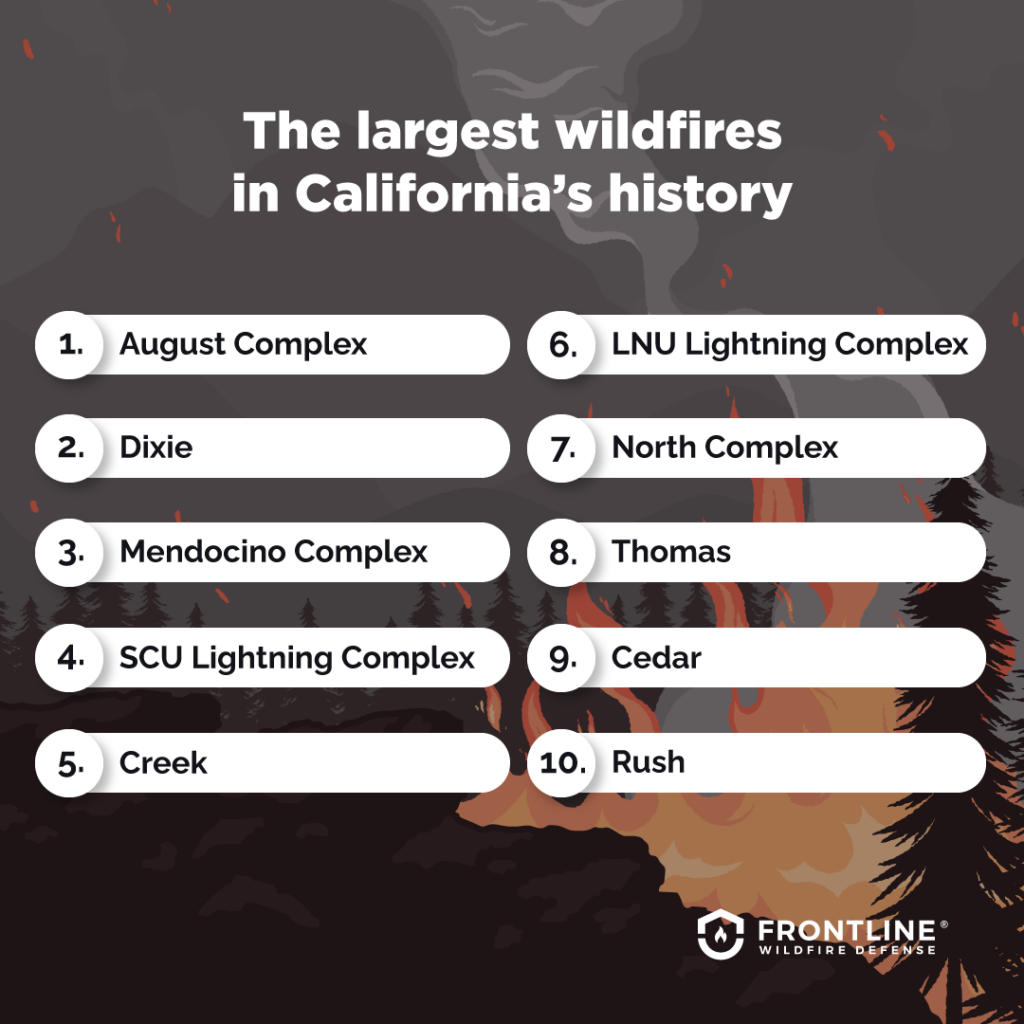
While California wildfire history includes thousands of fires every year, we’ve seen an uptick in mega-fires that cover over 100,000 acres. From 1900-1999, 45 mega-fires burned through the state. Since 2000, we’ve already had 35 mega-fires. Officials still debate the causes, which include poor forest management, increasing populations in fire zones, and climate change.
August Complex Fire (2020): the largest wildfire in California’s history.
The August Complex Fire was the result of around 30 separate lightning-caused fires in the Mendocino National Forest that eventually converged and burned over one million acres. Beginning in mid-August, the fire was finally completely contained on November 15, 2020.
In addition to destroying a significant amount of land, the August Complex Fire also destroyed 935 structures and resulted in one death.
About the Dixie Fire (2021).
When a 65-foot tall Douglas fir fell on a PG&E distribution line in July 2021, it sparked one of the largest blazes in California wildfire history. The area was dense with dry vegetation, fueling an inferno that burned 963,309 acres. The fire was so intense, it created its own weather, spawning lightning that ignited even more fires.
It’s worth noting that within the Lassen Volcanic National Park, fuel reduction efforts in the previous years slowed the fire’s progression and intensity within the park.
Two fires become one: Mendocino Complex Fire (2018).
The Mendocino Complex Fire started in July 2018, when a homeowner hammering a metal stake into the ground created a hot spark that landed on the extremely dry vegetation on his property. The resulting Ranch Fire then merged with the neighboring River Fire, creating a complex fire. The extreme humidity and triple-digit temperatures during the summer of 2018 created ideal conditions for these fires to spread and grow quickly, leading to the destruction of nearly 460,000 acres of land.
H3: About the SCU Lightning Complex Fire (2020).
Severe thunderstorms and numerous dry lightning strikes sparked wildfires in the Santa Cruz Unit (SCU) fire zone. Burning through over 396,000 acres, the SCU Lightning Complex Fire is the fourth-largest wildfire in California history. The fire destroyed 222 structures and took a month to fully contain.
H3: The Creek Fire in the Sierra National Forest (2020).
The Creek Fire began on September 4, 2020. While the official cause is listed as “undetermined,” the investigation found that it was likely started by a mix of lightning strikes, arson, and careless smoking.
The Creek Fire burned about 379,895 acres and 850 structures in Fresno and Madera counties. Fortunately, residents in the impacted areas were able to safely evacuate and the fire did not result in any deaths.
H3:About the LNU Lightning Complex Fire (2020).
A series of lightning strikes in the Sonoma-Lake-Napa Unit (LNU) in the early hours of August 17, 2020 started a major conflagration in California’s wine country. The blaze raged for months before containment was finally achieved on October 2, 2020. As the sixth-largest wildfire in California history, the LNU Lightning Complex Fire destroyed over 360,000 acres, nearly 1,500 structures, and took six lives.
California wildfire deaths by year.
| Ranking | Wildfire Name | Deaths | Structures Destroyed | Acres Burned | Year | Fire Cause | County |
| 1 | Camp | 85 | 18,804 | 153,336 | 2018 | Powerlines | Butte |
| 2 | Griffith Park | 29 | 0 | 47 | 1933 | Unknown | Los Angeles |
| 3 | Tunnel | 25 | 2,900 | 1,600 | 1991 | Extinguished fire rekindled | Alameda |
| 4 | Tubbs | 22 | 5,636 | 36,807 | 2017 | Electrical system | Napa & Sonoma |
| 5 | North Complex | 15 | 2,352 | 318,935 | 2020 | Lightning | Butte, Plumas, & Yuba |
| 6 | Cedar | 15 | 2,820 | 273,246 | 2003 | Human related | San Diego |
| 7 | Rattlesnake | 15 | 0 | 1,340 | 1953 | Arson | Glenn |
| 8 | Loop | 12 | 0 | 2,028 | 1966 | Unknown | Los Angeles |
| 9 | Hauser Creek | 11 | 0 | 13,145 | 1943 | Human related | San Diego |
| 10 | Inaja | 11 | 0 | 43,904 | 1956 | Human related | San Diego |
What can we learn from California’s wildfire history?
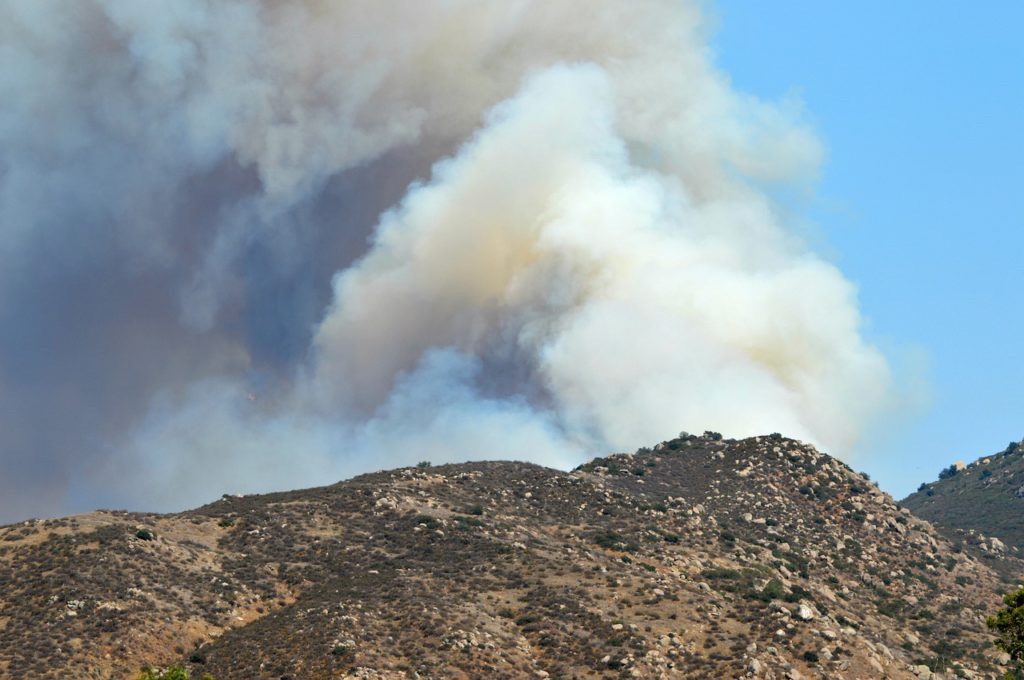
The increase in mega-fires is changing California. Bigger and more destructive fires are increasingly common in an already worsening situation. The state’s hot and dry conditions are more severe due to climate change. A growing population in at-risk areas means that more fires will start—90% are human caused—and dense population centers mean more homes will be affected. Poor forest management practices are adding more fuel to fires. Of the human-caused wildfires, problems with electrical infrastructure are responsible for half of the most destructive fires.
All of this means that fire seasons are getting longer. During drought years, optimal conditions for wildfires exist year-round. California residents must practice proper fire safety every day and protect their homes from the dangers presented by wildfires throughout the year.
Despite the danger, more homes are being built in wildfire-prone areas. Population pressures are putting more people into homes in high-risk burn areas. Here’s a look at California wildfire data related to at-risk homes:
- Nearly 2 million homes in California, one in ten buildings, are listed as being in areas of “extreme risk of wildfire”, according to the Insurance Institute for Business & Home Safety.
- Between 1990 and 2010, 12 million homes were built in wildland-urban interface zones at high fire risk.
- State-mandated Fire Hazard Severity Zone maps, updated in 2022, identify the probability of a fire in a given area. Communities in wildland-urban interface areas, which are developments on the edge of cities and towns, are at high risk.
- FEMA has studied a variety of proposed mitigations to combat the threat of wildfire.
- The potential property damage in high-risk areas is estimated at $610 billion.
- A study by Next 10 proposes that for every dollar spent on fire mitigation, $3 in recovery costs could be saved.

Set up your own wildfire defense system.
While authorities study California wildfire data and develop plans, you can take proactive steps now to address the threat of wildfires to your property. As you harden your home against wildfires, keep in mind that wind-driven wildfire embers are the biggest threat to your property.
A wildfire sprinkler system that addresses the vulnerabilities on your roof and property can create “too wet to burn” areas that make ember ignition difficult.
Learn how the Frontline Wildfire Defense System, backed by wildfire science, can greatly increase the chance your structure will survive a wildfire.
